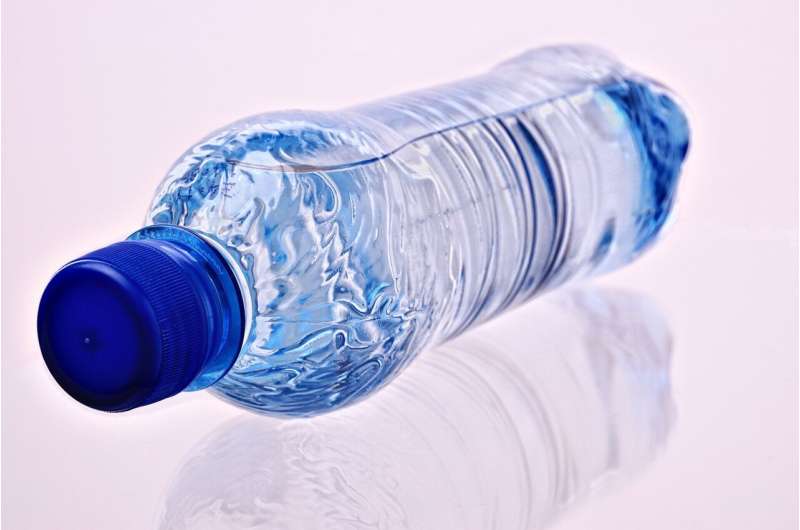
Credit: Pixabay/CC0 Public Domain
A study out recently has prompted much media attention about the role of plastics in developing autism.
In particular, the study focused on exposure to a component of hard plastics—bisphenol A, or BPA—in the womb and the risk of boys developing this neurodevelopmental disorder.
Importantly, the study doesn’t show plastics containing BPA cause autism.
But it suggests BPA might play a role in estrogen levels in infant and school-aged boys, which can then affect their chance of being diagnosed with autism.
Let’s tease out the details.
Remind me, what is BPA?
BPA is a component of hard plastics that has been used for a few decades. Because BPA is found in plastics used for food and some drink containers, many people are exposed to low levels of BPA every day.
But concerns about how BPA impacts our health have been around for some time because it can also weakly mimic the effects of the hormone estrogen in our body.
Even though this action is weak, there are worries about health because we are exposed to low levels across our lifetime. Some countries have banned BPA in baby bottles, as a precaution; Australia is voluntarily phasing it out in baby bottles.
What is autism and what causes it?
Autism is a neurodevelopmental disorder diagnosed based on difficulties with social communication and repetitive and/or restrictive behaviors.
People with autism may experience other issues, such as seizures, changes in motor function (for example, difficulties with fine motor coordination, such as holding a pencil or turning a key to open a door), anxiety, sensory issues, sleeping problems as well as gut upsets.
There’s a broad range of the intensity of these symptoms, so people with autism experience daily life in vastly different ways.
So far most studies have described autistic people who are able to interact very well in the community, and in fact may demonstrate outstanding skills in certain areas. But there’s a big gap in our knowledge around the large number of profoundly autistic people, who require 24-hour care.
There is a strong influence of genetics in autism with more than 1,000 genes associated with it. But we don’t know what causes autism in most cases. There are a few reasons for this.
It is not standard practice to undertake detailed gene sequencing for children with autism. Although there are clearly some individual genes responsible for certain types of autism, more often autism may result from the complex interaction of many genes which is very difficult to detect, even in large scale studies.
Environmental factors can also contribute to developing autism. For example, some antiseizure medications are no longer prescribed for pregnant women due to the increased risk of their children developing neurodevelopmental disorders, such as autism.
This latest study looks at another possible environmental factor: being exposed to BPA in the womb. There were several parts to the research, including studies with humans and mice.
What did they find in humans?
The researchers looked at a group (or cohort) of 1,074 Australian children; roughly half were boys. They found 43 children (29 boys and 14 girls) had an autism diagnosis by age seven to 11 (average age nine years).
They collected urine from 847 mothers late in their pregnancy and measured the amount of BPA. They then focused their analysis on samples with the highest levels of BPA.
They also measured gene changes by analyzing blood from the umbilical cord at birth. This was to check aromatase enzyme activity, which is associated with estrogen levels. Children with gene changes that might indicate lower levels of estrogens were classified as having “low aromatase activity.”
The team found a link between high maternal BPA levels and a greater risk of autism in boys with low aromatase activity.
In the final analysis, the researchers said there were too few girls with an autism diagnosis plus low aromatase levels to analyze. So their conclusions were limited to boys.
What did they find in mice?
The team also studied the effect of mice being exposed to BPA in the womb.
In mice exposed to BPA this way, they saw increased grooming behavior (said to indicate repetitive behavior) and decreased social approach behavior (said to indicate reduced social interaction).
The team also saw changes in the amygdala region of the brain after BPA treatment. This region is important for processing social interactions.
The researchers concluded that high levels of BPA can dampen the aromatase enzyme to alter estrogen production and modify how neurons in mouse brains grow.
But we should be cautious about these mice results for a number of reasons:
- we cannot assume mouse behavior directly translates to human behavior
- not all mice were given BPA using the same method—some were injected under the skin, others ate BPA in a sugary jelly. This may influence levels of BPA the mice actually received or how it was metabolized
- the daily dosage delivered (50 micrograms per kilogram) was higher than the levels people in Australia would be exposed to, and much higher than levels found in the mothers’ urine in the study.
What’s the take-home message?
Finding a link between two factors—in this case BPA exposure in the womb and autism—doesn’t say one causes the other.
However the researchers do propose a mechanism, based on their mice study. They propose that high levels of BPA can dampen the aromatase enzyme to alter estrogen production and modify how neurons in mouse brains grow.
Have we found what causes autism? Based on this study alone, no. Not all babies of women with BPA in their urine had autism, so exposure to these plastics alone isn’t sufficient to cause autism. There are likely a range of factors, including genetics, that contribute.
This study does hint, however, that there could be a gene-environment interaction and babies with certain gene variations could be more susceptible to BPA effects and have an increased risk of autism. But we would need more research to clarify.
It’s important to understand there are many other possible contributors to autism with similar amounts of evidence. And ultimately, we still don’t know for sure what causes autism for most people.
This article is republished from The Conversation under a Creative Commons license. Read the original article.![]()
Citation:
Do plastics cause autism? Here’s what the latest study really says (2024, August 10)
retrieved 17 August 2024
from https://medicalxpress.com/news/2024-08-plastics-autism-latest.html
This document is subject to copyright. Apart from any fair dealing for the purpose of private study or research, no
part may be reproduced without the written permission. The content is provided for information purposes only.
Note: This article have been indexed to our site. We do not claim legitimacy, ownership or copyright of any of the content above. To see the article at original source Click Here













